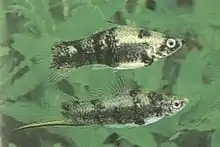Marbled swordtail
The marbled swordtail (Xiphophorus meyeri) is a species of freshwater fish in the family Poeciliidae. It was endemic to the Rio Salado system (itself a part of the Rio Grande basin) in northeastern Mexico.[2][3]
| Marbled swordtail | |
|---|---|
 | |
| Scientific classification | |
| Kingdom: | Animalia |
| Phylum: | Chordata |
| Class: | Actinopterygii |
| Order: | Cyprinodontiformes |
| Family: | Poeciliidae |
| Genus: | Xiphophorus |
| Species: | X. meyeri |
| Binomial name | |
| Xiphophorus meyeri Schartl & Schröder, 1988 | |
The marbled swordtail is considered extinct in the wild by the IUCN, meaning that it only survives in captivity at the Xiphophorus Genetic Stock Center, Texas State University.[1] The marbled swordtail shared the title as northernmost naturally distributed Xiphophorus with the closely related Monterrey platyfish (X. couchianus) and northern platyfish (X. gordoni).[3][4] The specific name of this species honours the German ichthyologist Manfred K. Meyer.[5]
References
- Almada-Villela, P.; Contreras-Balderas, S. & Hendrickson, D. (2019). "Xiphophorus meyeri". IUCN Red List of Threatened Species. 2019: e.T23158A2784905. doi:10.2305/IUCN.UK.2019-2.RLTS.T23158A2784905.en.
- Froese, Rainer and Pauly, Daniel, eds. (2018). "Xiphophorus meyeri" in FishBase. September 2018 version.
- Ceballos, G.; E.D. Pardo; L.M Estévez; H.E. Pérez, eds. (2016). Los peces dulceacuícolas de México en peligro de extinción. p. 283. ISBN 978-607-16-4087-1.
- Kang, J.H.; M. Schartl; R.B. Walter; A. Meyer (2013). "Comprehensive phylogenetic analysis of all species of swordtails and platies (Pisces: Genus Xiphophorus) uncovers a hybrid origin of a swordtail fish, Xiphophorus monticolus, and demonstrates that the sexually selected sword originated in the ancestral lineage of the genus, but was lost again secondarily". BMC Evolutionary Biology. 13 (25): 25. doi:10.1186/1471-2148-13-25. PMC 3585855.
- Christopher Scharpf; Kenneth J. Lazara (26 October 2019). "Order CYPRINODONTIFORMES: Families POECILIIDAE, ANABLEPIDAE, VALENCIIDAE, APHANIIDAE and PROCATOPODIDAE". The ETYFish Project Fish Name Etymology Database. Christopher Scharpf and Kenneth J. Lazara. Retrieved 9 November 2019.
This article is issued from Wikipedia. The text is licensed under Creative Commons - Attribution - Sharealike. Additional terms may apply for the media files.
